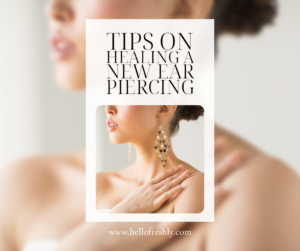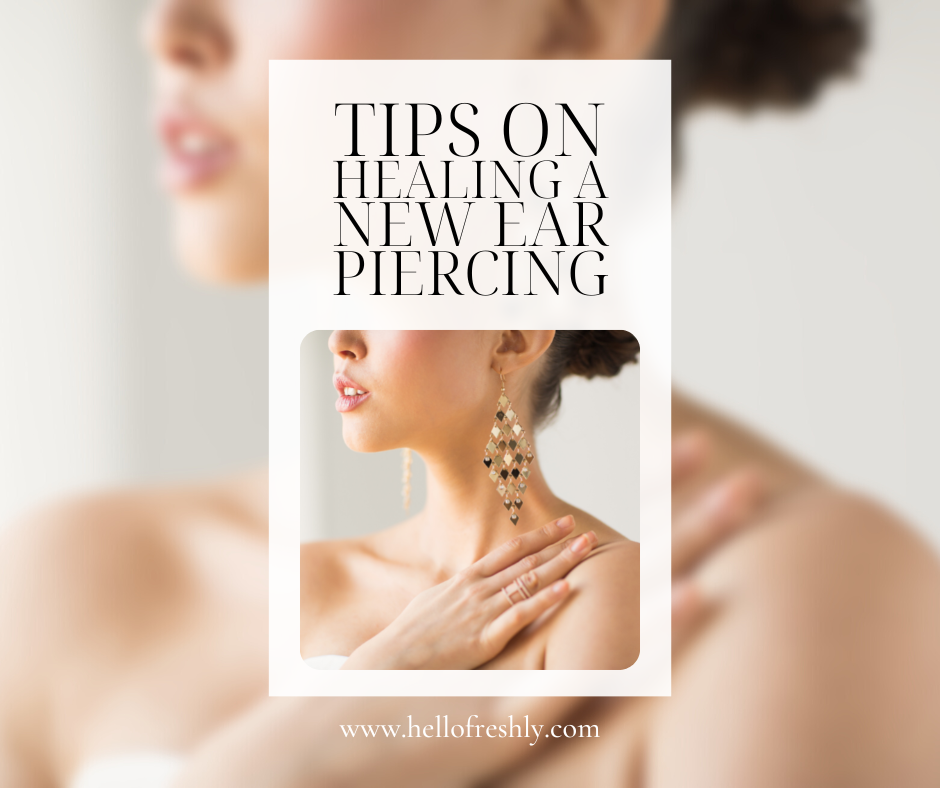
Do you have a new ear piercing? Congratulations! You’ve survived that minute pinch to your ear and are now enjoying fancy new jewelry for your ears. But the pinching is the easy part, I’m afraid—now, it’s time to let that new ear piercing have healing. We know it’s difficult since we know you’re itching to start switching earrings as soon as possible, but it’s important to let your piercing heal first!
To heal a new ear piercing as quickly as possible, it’s important to follow proper aftercare guidelines to prevent infection and promote healing. Here are some steps you can take:
1. Clean Your Ear Piercing
Clean the new piercings with saline solution or a saline wipe twice a day. This will help to remove any excess discharge or crusting that may form around the piercing. Always wash your hands before doing the cleaning to prevent dirty hands from transferring bacteria to the fresh piercing. And dry the area thoroughly after cleaning.
Make sure you only use saline solution. Using rubbing alcohol can dry your skin and make the healing process longer. It kills off bacteria and healthy cells that are helping the piercing heal. Not cleaning at all is also bad as you need to flick off harmful bacteria.
2. Avoid Touching the New Piercing
As we mentioned earlier, touching your new piercings with dirty hands can introduce bacteria to the wound, so be sure to avoid touching your ears as much as possible or at least make sure your hands are clean before touching them gently.
Additionally, touching the new piercing would hurt considerably. It’s like purposefully touching a broken leg—it doesn’t do anything but put pressure on something that already hurts.
3. Avoid Sleeping on the New Piercing
Try to sleep on your back or on the opposite side of the piercing to avoid pressure on the new hole, which can irritate. If both of your ears have fresh piercings, try positioning your head on the pillow in a way that’ll cause less interaction with the new piercing. There are also pillows with holes in the middle specifically for people with new piercings.
4. Avoid Swimming, Hot Tubs, and Saunas
Avoid submerging your new piercings in water or exposing them to high temperatures as this can introduce bacteria to the wound and delay healing. Your piercer should give you a rough estimate as to when you can start doing these activities. The bare minimum is 24 hours after your ears have been pierced, but you should ideally avoid doing them until the piercings have healed a bit (around two weeks).
Make sure to clean the piercings thoroughly after every activity.
5. Avoid Having Items Around Your New Piercing
Avoid using things like helmets, earbuds, or headphones as they can cause pressure on the new piercing and can also introduce bacteria to the wound. You always want to keep things out of the way of the new piercing as not only is it messy, but painful. That’s why we also recommend putting your hair up as stray hairs can get stuck in between the earrings too.
6. Don’t Remove the Earring
Keep the earring in the piercing for the entire healing period as removing it before the piercing is fully healed can cause the hole to close. Besides that, removing the earring before it is fully healed hurts, and you’ll have a hard time putting that earring back in (if you can stand the pain), believe us.
Generally, you’ll want to wait until after the swelling, pain, and discharge are gone before you can switch earrings.
7. Be Patient
Healing times can vary from person to person, but most ear piercings take a few months to even a year to heal completely. Be patient and give your ear time to heal. It’s not going anywhere, and in a year, you can play around with your earrings as much as you want as a reward for being so patient!
8. Consult Your Ear Piercer or Healthcare Professional
It’s also important to note that if you notice any signs of infection, such as redness, swelling, or discharge, you should contact a healthcare professional for advice on what medications to take. They can also look for signs of something more dangerous like dying tissue (especially if it’s cartilage piercing) as this can cause permanent damage to your ear.
You may also contact your ear piercer. They can give you advice on what to do next. For example, if the infection is particularly bad, they might recommend you remove it entirely to prevent further damage to the ear. They usually also have ear-piercing healing items on hand if you ever need them.
